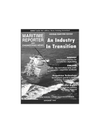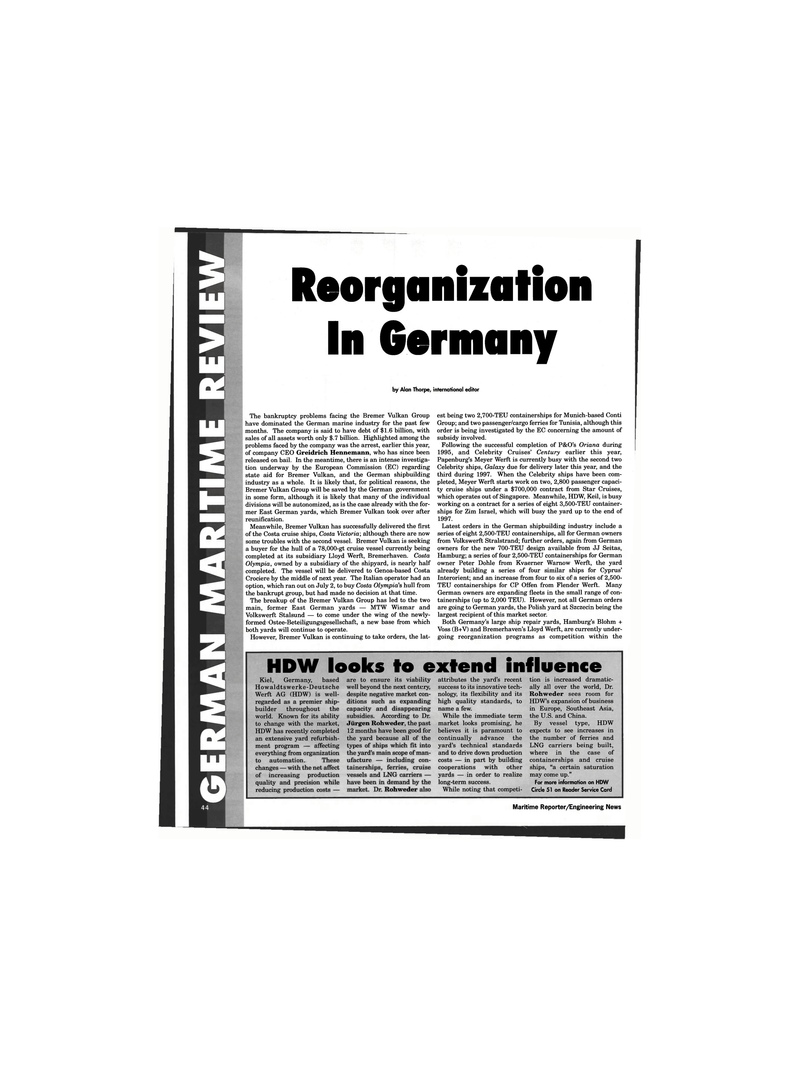
Page 44: of Maritime Reporter Magazine (September 1996)
Read this page in Pdf, Flash or Html5 edition of September 1996 Maritime Reporter Magazine
Reorganization
In Germany by Alan Thorpe, international editor
The bankruptcy problems facing the Bremer Vulkan Group have dominated the German marine industry for the past few months. The company is said to have debt of $1.6 billion, with sales of all assets worth only $.7 billion. Highlighted among the problems faced by the company was the arrest, earlier this year, of company CEO Greidrich Hennemann, who has since been released on bail. In the meantime, there is an intense investiga- tion underway by the European Commission (EC) regarding state aid for Bremer Vulkan, and the German shipbuilding industry as a whole. It is likely that, for political reasons, the
Bremer Vulkan Group will be saved by the German government in some form, although it is likely that many of the individual divisions will be autonomized, as is the case already with the for- mer East German yards, which Bremer Vulkan took over after reunification.
Meanwhile, Bremer Vulkan has successfully delivered the first of the Costa cruise ships, Costa Victoria; although there are now some troubles with the second vessel. Bremer Vulkan is seeking a buyer for the hull of a 78,000-gt cruise vessel currently being completed at its subsidiary Lloyd Werft, Bremerhaven. Costa
Olympia, owned by a subsidiary of the shipyard, is nearly half completed. The vessel will be delivered to Genoa-based Costa
Crociere by the middle of next year. The Italian operator had an option, which ran out on July 2, to buy Costa Olympia's hull from the bankrupt group, but had made no decision at that time.
The breakup of the Bremer Vulkan Group has led to the two main, former East German yards — MTW Wismar and
Volkswerft Stalsund — to come under the wing of the newly- formed Ostee-Beteiligungsgesellschaft, a new base from which both yards will continue to operate.
However, Bremer Vulkan is continuing to take orders, the lat- est being two 2,700-TEU containerships for Munich-based Conti
Group; and two passenger/cargo ferries for Tunisia, although this order is being investigated by the EC concerning the amount of subsidy involved.
Following the successful completion of P&O's Oriana during 1995, and Celebrity Cruises' Century earlier this year,
Papenburg's Meyer Werft is currently busy with the second two
Celebrity ships, Galaxy due for delivery later this year, and the third during 1997. When the Celebrity ships have been com- pleted, Meyer Werft starts work on two, 2,800 passenger capaci- ty cruise ships under a $700,000 contract from Star Cruises, which operates out of Singapore. Meanwhile, HDW, Keil, is busy working on a contract for a series of eight 3,500-TEU container- ships for Zim Israel, which will busy the yard up to the end of 1997.
Latest orders in the German shipbuilding industry include a series of eight 2,500-TEU containerships, all for German owners from Volkswerft Stralstrand; further orders, again from German owners for the new 700-TEU design available from JJ Seitas,
Hamburg; a series of four 2,500-TEU containerships for German owner Peter Dohle from Kvaerner Warnow Werft, the yard already building a series of four similar ships for Cyprus'
Interorient; and an increase from four to six of a series of 2,500-
TEU containerships for CP Offen from Flender Werft. Many
German owners are expanding fleets in the small range of con- tainerships (up to 2,000 TEU). However, not all German orders are going to German yards, the Polish yard at Szczecin being the largest recipient of this market sector.
Both Germany's large ship repair yards, Hamburg's Blohm +
Voss (B+V) and Bremerhaven's Lloyd Werft, are currently under- going reorganization programs as competition within the
HDW looks to extend influence
Kiel, Germany, based
Howaldtswerke-Deutsche
Werft AG (HDW) is well- regarded as a premier ship- builder throughout the world. Known for its ability to change with the market,
HDW has recently completed an extensive yard refurbish- ment program — affecting everything from organization to automation. These changes — with the net affect of increasing production quality and precision while reducing production costs — are to ensure its viability well beyond the next century, despite negative market con- ditions such as expanding capacity and disappearing subsidies. According to Dr.
Jiirgen Rohweder, the past 12 months have been good for the yard because all of the types of ships which fit into the yard's main scope of man- ufacture — including con- tainerships, ferries, cruise vessels and LNG carriers — have been in demand by the market. Dr. Rohweder also attributes the yard's recent success to its innovative tech- nology, its flexibility and its high quality standards, to name a few.
While the immediate term market looks promising, he believes it is paramount to continually advance the yard's technical standards and to drive down production costs — in part by building cooperations with other yards — in order to realize long-term success.
While noting that competi- tion is increased dramatic- ally all over the world, Dr.
Rohweder sees room for
HDW's expansion of business in Europe, Southeast Asia, the U.S. and China.
By vessel type, HDW expects to see increases in the number of ferries and
LNG carriers being built, where in the case of containerships and cruise ships, "a certain saturation may come up."
For more information on HDW
Circle 51 on Reader Service Card 46 Maritime Reporter/Engineering News

 43
43

 45
45
